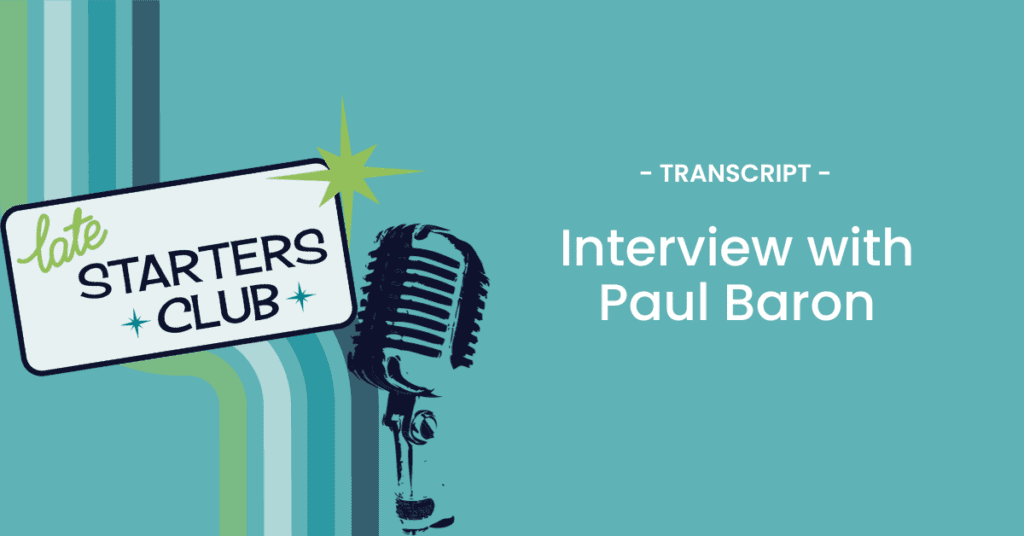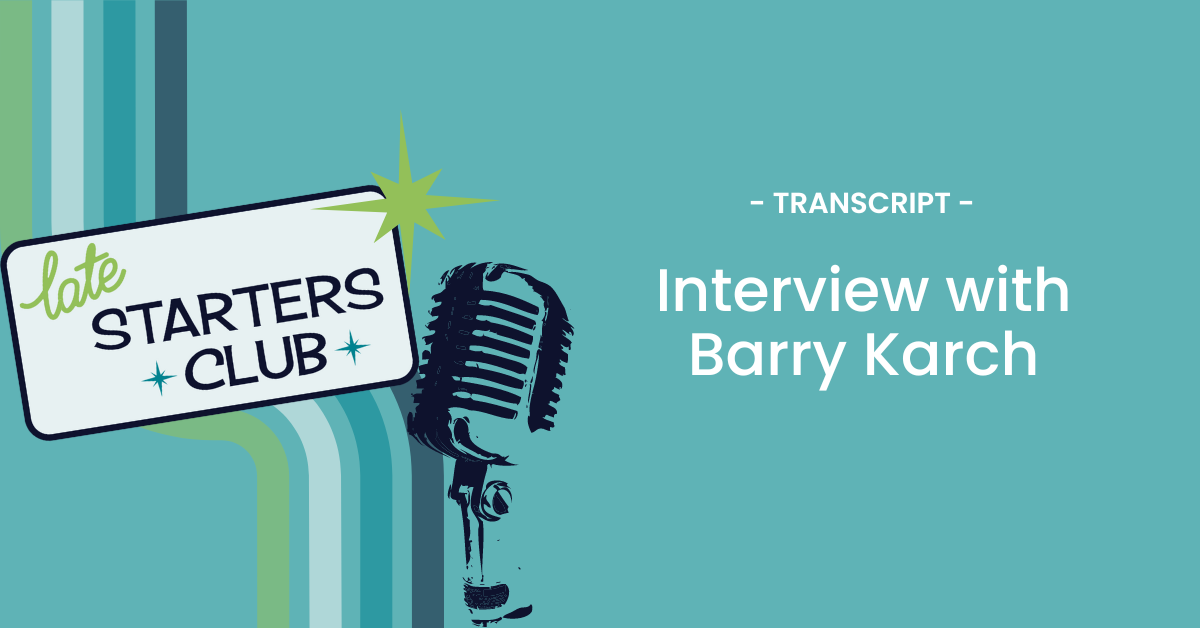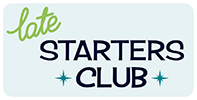Subscribe Apple | Google | Spotify | Stitcher | iHeart Living the Dream Overseas with Christine Gritmon Have you had a lifelong dream to live overseas and haven't made that happen yet? Maybe things have gotten in the way like family, jobs, life. My...
Ep163 Transcript: Interview with Paul Baron

Andrea Vahl: Tune in. As we listen to Paul Baron talk about how he has partnered with a firm in China to bring this product to the U. S.
Hello, dreamers. Welcome to the late starters club, giving you the inspiration, mindset, and tools you need to start something midlife and beyond remember, it’s never too late to follow your dreams.
It’s starters. It’s your host, Andrea of all. And I am here joined by Paul Baron, the inventor of the wall printer. And I’m super excited to dive into this today because we’ve had a lot of like entrepreneurs on this show. A lot of people have started businesses, but not that many inventors. And so that’s, what’s fun about diving into today’s topic.
And so welcome Paul.
Paul Baron: Thank you very much, Andrea. Pleasure to be here with you and your audience.
Andrea Vahl: Yeah. So you invented the wall printer at…
Paul Baron: Let me correct you, let me just correct you just for the benefit of your audience and the conversation while I am a co-inventor on several patents for the machine, the technology itself that’s at the root of the vertical and floor printing machines that we manufacture and distribute to put people in business today was invented in Southeast Asia.
The core technology, then I improved upon it and became a co-inventor, which is actually a credit to not only the manufacturer, but also to my company that we are co inventors on certain patent applications where I saw a need for improvements in the product and the technology. Technically the technology did originate prior to my joining the company.
But I recognized it as something that was innovative, something that was really literally unknown and unheard of in the United States, Canada, all of North and South America, actually, it was confined to Southeast Asia, a little bit in Europe when I discovered it, and then I brought it to market as a machine that would help people make money or improve their lives by putting artwork onto walls or floors.
That’s the background.
Andrea Vahl: Yeah. Yeah. Good. And that’s always important because I understand like in patents and things like that, you want to make sure that you’re not taking credit on credit where it’s not where it deserves to be mentioned that it was a co invention or technology was there, but I love what it does.
So tell our audience a little bit about what.
Paul Baron: I don’t generally make these conversations a pitch for my current company. I’m 72 years old, which I guess fits into a late starter category. I started this company at the age of 68. It’s one of. journey of 20 or more companies that I’ve either founded, created, worked for retired several times it wasn’t a trajectory like the traditional hockey stick that people dream about where everything goes from zero to 100 without any pitfalls or anything else.
I don’t know anybody’s journey that goes like that, even though they may state So. Everything has its learning experiences. I call those valleys and drops. And then you have your successes and your high points. You hope that the high points outweigh the learning experiences, as I call those. But in any case four years ago, five years ago I was introduced to a a technology by a company that’s actually now a competitor of mine.
That I had never seen or heard about before. It was a machine that basically took any digital art and printed it. not painted, but printed it with inks onto any wall, any vertical surface. It didn’t have to be a smooth wall. It could be brick or stucco or slight recesses like a garage door. Or it could be on concrete, on wood, vinyl plastic glass.
Metal, tile, anything any wall, as long as it was vertical you could take a digital image and print it and it didn’t matter how wide it was, how high it was there are ways of using the machine that could go without limitations of height or width. So it was used to wall anything from small text, like the menu of a restaurant or somebody’s name on a door in their office.
To the picture of a dog here’s my dog with Santa Claus on the wall behind me, that’s a wall printing on paper because my wife doesn’t like when I print on the walls in the house so you can print, and the one above me is a wall printing on canvas which is a bunch of my friends that we get together every now and then, and Gave that to them as Christmas presents last year on canvas.
That’s a wall print also. But it was an interesting machine that I’d never seen or heard about before. And while the company that approached me to market it, because that’s my background, is marketing innovative products and finding their high value audiences in the United States. And that’s what I made a career out of, taking a baby bottle manufactured in Austria, a self service dog wash system from Australia.
Software that is for audio and video and navigation system technology from Russia and from Israel. And a headband headphone from China. This is what I’ve done for my career is take a product that’s innovative, that has either a need or a need to grow or a need to be introduced to the American audience.
And I was basically the American face on these companies products. And I helped them either find their customers, reach some level of success, exit, or partnerships, find their strategic relationships, manufacturers, whatever. But I retired several times, as I mentioned over the years. And at those times, I got restless very quickly.
And I’m always looking for something else. In my forties, fifties, sixties, and now seventies. Generally when I say to my wife Maureen, come take a look at this. And I’m in my home office where I am right now. Rather than come and look at what I’m talking about, generally, she cuts up my credit cards and then changes all the passwords on our bank accounts.
Here we go. Paul’s going to invest or get into something crazy again. This time she was all in when she saw this machine. However, the company that approached me, they wanted me like many of my. Prior engagements, they wanted me to be a kind of a hired gun, a commissioned salesperson for them. And years ago I stopped doing that.
If I liked something, I was going to invest in it. I was going to own it. I was going to have some control and equity because I’ve invariably found out that some of the products. lacked something or can be improved in some way. And unless you have ownership and control, it’s very hard to do that with somebody else who takes ownership of their products and is so in love with it that they don’t want to hear something else and somebody else’s opinion or ideas.
They’re happy with the way it is and they just wanted me to sell it. But I got tired of doing that. So anyway, so I stopped the conversation with this company that approached me. And even though it was a cool product but I got off. the conversations I had with them with the feeling that this was something really cool.
How come I’ve never seen or heard about it before? Which is the first thing I have to ask myself before I get involved in something. And so I did my homework, same homework I hope my customers do today. Who’s doing this? Can I make money with it? What is it for? What do you do with it? What am I going to do with it?
What do I need to do something with it? And all those questions that have to be asked. It turns out that there’s only a handful, literally five companies in the world that manufacture this type of technology. None of them are in the Western hemisphere. There was a German company, two Chinese companies, an Australian and an Indian company.
And they all lacked something that I thought was really interesting about the technology, except for one Chinese company that was actually the originator of the technology. And it also had some things that were lacking, but some things that made it much more interesting to me than the other products.
And without getting into the technical aspects, just suffice to say that I was really attracted to the product. I saw its potential. And this company was in a, what’s the right word? They were in a mood or they were receptive to me joining them and investing in it and helping them launch the product in North and South America.
Which markets that they or nobody else were in at the time. And we had our courtship for about a year and we eventually, we agreed on the relationship and how it would be structured and the investment I would make in it. And we began our path together and in, let’s say November of 2019 is when I first received my first shipment of machinery from them which required some changes, improvements, and.
Things converting it from Chinese to English and French, Canadian and Spanish and Portuguese, all the markets I was going to serve. So I had to do all that. Now, I wasn’t the smartest kid on the block, Andrea, when I created this company in November of 2019. And then in January of 2020, less than really a month after I received all these initial machinery.
Components. The world stopped with COVID as we well know.
Andrea Vahl: So that, that definitely would have been a challenge that would have that would have been a huge issue with launching things. Just to recap and make sure I understand like how things worked, they already had the technology and you just came up with some improvements on it, but then we’re also marketing it.
So that’s an interesting thought as well for people who maybe are thinking they’ve got some possible idea. Maybe it’s a good thing to see is anything else out there. If there is something else out there that’s similar, maybe it’s an opportunity market it or to add to it and then partner instead of having to come up with the whole entire idea yourself and figure out how to get it manufactured, et cetera, et cetera.
Paul Baron: Andrea, that’s not only great observation and questions buried in there. But it’s also exactly what I went through and the challenges when, as I yeah, Left off saying I started this company really when COVID came around and here we were at a time and I’ll mention two things in, in, to the point of what you just brought up I created this company, like I’ve done many things in my career with in mind.
What is somebody else going to do with it? What is somebody, just like I would maybe make improvements on it or find a niche, whether it be the customers, whether it be vendors strategic partnerships customers, business owners, whatever the place was for the service, product, software, technology, whatever it was that I found interesting enough to represent or grow.
It had to have an audience and, who wants it, what are they going to do with it? And while COVID came around in January of 2020 basically shutting the world down, people were being laid off, people were working remotely, they still are today, three, four years later and While that was a challenge to many companies out there and actually brought many companies down as a result of that I looked at that as an opportunity because what I wanted out of this product was to create business opportunities for others, whether they be a startup like myself who’s looking for something to To invest in or to or to take on themselves to create a revenue stream and a business for themselves, for their family, for their communities.
It’s all about what will it do for that customer. And that customer falls into generally two buckets. The person who is out of work or laid off or retired even because many of our audience, just like the audience you look to when you asked me, invited me to be here to talk with you late in life when I was in my sixties, I started this.
Company half of our customers. Maybe not half but about 25 to 35 Of our customers today and we have now in three years 135 customers and a customer to me Is a is an entity that I created a business for what they created a business using the technology I provide and supply, train and support.
And so out of those 135 customers, I’d say a good 25 to 30 of them, 20 to 30 percent are people who were retired, who just are also like I was looking for something because they’re restless and even though they may be. On in life, they still they’re not finished yet. And they’re looking for things and and that might be out of circumstance because they did get laid off from a job or they’re looking for a career change or they’re retired and they’re just restless.
And so if they fall into any of those buckets, they were an ideal customer for us because this was something new and innovative. It does require something of a risk taking personality. To take on something brand new. It’s not buying into a coffee shop or a plumbing business or becoming a lawyer or an accountant, or, buying a hamburger place coffee shop, these are things that you can see that you understand what they are because they’re all around us.
Here was something, a machine that prints images on walls. How do I get images and pictures on walls? I can buy a framed picture. I can throw up a final sticker on a wall. I can wallpaper a wall. I could paint a wall with an artist and a muralist. These are the ways you can do it. Very limited numbers of ways to do things, and they all have their limitations, whether time, cost, surface.
That’s what I loved about this technology.
Andrea Vahl: Yeah. It’s awesome technology. I think that’s the cool thing. So one of the questions I want to get into a little bit how did you approach the financial part of starting this business? Obviously, you had to invest a lot into it.
And so how did you. Make that decision and make that leap into saying, Hey, it’s 68, I’m going to make a big investment, maybe take a risk. What was it for you that let you say, you know what, I think that this is going to work. Did you do some analysis on the risk that you were taking with starting the company?
Paul Baron: Nothing should be entered into without some analysis, whether it’s looking into yourself and deciding, are you prepared to take a risk, make a change, go this path, whether it be through education, through career choices, through your family’s necessities, whatever decisions you make that are going to dictate whether you own a business, work for a business or do nothing has to have some type of foundation of analysis of where you are in your life and what are your hopes and dreams for the future.
I always say that the ingredients to any business decision should be routed in three basic things. I call them time, talent and treasure. You have to have the time to devote to do that analysis, to market research, find out, is this really a solution to a problem out there, or are you really enamored by something and you’re going to look for a problem to solve that doesn’t really exist.
It has to be a real problem, a real market gap. So it requires the time it takes to And to
come up with that conclusion, it requires that you have a certain amount of talent to be able to do this or people always ask me what makes a good CEO or a good leader of a company? I’m not going to sit here with you and your audience and profess to be that person.
But it’s a question that I’m often asked and that I often ask myself and my answer. Over the years I’ve learned is this what makes a great leader or a great CEO of a company or the great owner of a company is somebody who’s. Smart enough to understand the job that needs to be done, but is wise enough to back off and let the better qualified people do it.
You can hire people to do things that you don’t have the talent to do, but you also have to be wise enough to back off and let them do it, and to reach the goals that you’re looking for, whether they be financial, customers, Markets, what have you R& D anything requires that kind of combination of talent, which some people may possess all those hats and wear those hats.
I learned early on in my life the hats I like to wear were sales and marketing, relationships. Finding, identifying, building relationships with people and companies and vendors I, that’s what really got me up in the morning and got me out of bed is looking forward to who am I going to meet there’s the old saying, be nice to the people on the way up, they’re the same people you’re going to see on the way down nothing could be further from the truth, the relationships you make in your life, whether it’s from grade school college, work, career choices that you’ve made the people that are in your life whether they were a resource to you or whether they were a co worker a confidant a mentor these are the relationships that are going to define your life generally of who you are as a person and who you become and how you succeed and how you how you identify those things you’re willing to take a risk on.
And then treasure. Okay, that’s the time talent and the last one treasure. Yes, you need capital. Most businesses do even if the business itself that you’re thinking about or desiring, even if it’s a job change, you need the capital to feed your family to get to work to have an automobile or have the ability to take a bus or subway or train or plane.
And do the things that you need to do to be able to work. Feel good about yourself and the company you work for and the job at hand that you’re either building or working with So that requires some type of capital and certainly if you’re going to take a risk on something you have to have that mental What’s the right word?
The mental fortitude, the mental aptitude, the tolerance to take that risk That’s something I’ve been, I’d say blessed with in a combination with the relationships I’ve made at those times in my life that I may not have had the confidence that I can do what I wanted to do. Other people would tell me, yes, you can, or no, you shouldn’t.
And because I listened to many people who I trust and value I was able to go on different paths and when I wanted to take a risk. Sometimes I had the confidence that I would do it. Did that mean it succeeded? No, i’ve had failures or I like to call them learning experiences. But there were those times that the intention did not work out.
The way that I had anticipated But I was always willing to take the risk and I always had the confidence in myself that I could pick myself up And start again trite phrases. Notwithstanding, it’s not how many times you fall down. It’s how many you get up. I was always ready to get up and I will also ready not to look back.
I learned from the, from what happened earlier, whether successful or not. But I never looked back and regretted anything. If I sold something, if I left something, if I started something, I didn’t look back and play the what if game. I think all of those things are also important to define the path you’re going to take, the risk you’re willing to take, and how successful you’re going to be, or keeping your options open to knowing when you need to pivot.
Andrea Vahl: Yeah. Yeah, for sure. That’s a tough, that is a tough thing to recognize. And so you’ve had a lot of businesses over the years. How have you decided when it’s time to exit versus when it’s time to push through? Is there anything you do to really make that decision if you are supposed to lean in harder and push harder or time to close up shop and move to the next thing?
Paul Baron: That’s a great question, Andrea, and it’s something that, of course, everybody who is going to pivot, from whether it be a job or a business you know, buying a car, selling a car, I don’t care what it is that you’re doing you have to make that decision. I think your question is now the right time.
Why am I doing this? What’s going to happen next? Is it going to be beneficial? Is it going to be taking two steps back to take five steps forward? So those are all the questions that do have to be asked. Me personally, I always learned from everything I did. Again, not meaning that it was successful all the time, but I always learned from it.
Early on in my life, somebody told me something which stuck with me to this day, which is why I do the things I do and I’m willing to take it upon myself and take the risks myself. I worked for a company at a very early age when I was in my twenties, I was making more money than I thought I would make at that time I was working in sales office operations position for a manufacturing and distribution company. After my first year there I got a thousand dollar bonus check at Christmas, the first Christmas I worked there.
I was as happy as could be. I was making a good salary besides, but getting this 1, 000 bonus at Christmastime, I felt. very appreciative and very proud that the company recognized the accomplishment that I had done for it in my role. And so my mother happened to be the bookkeeper of this company, my mother said to me that all the owners of the company, each wrote themselves a check for 25, 000 because she had that inside information.
And so I said Okay. I just put that in the back of my head. But then Monday when I went into the office, I went to the owner and I said, thank you so much for that bonus check. I really appreciate it. Enjoy working here. I said now or at the first of the year, I think that I’m due for a raise.
And so he said to me something which I’ll share with you and your audience. And it stuck with me throughout my entire life when I had to hire people. Or when I work for other people, he said to me, he said, Paul, you’ve done a great job, we appreciate what you’ve done. And we felt really good about being able to give you that bonus and you definitely deserved it.
He said, but I’m going to tell you this, Paul, whenever you work for somebody, you will never make as much as you think. You’re worth, but when you work for yourself and you take the risks, that’s when whatever you get will be what you are worth, but working for me, I’ll make sure you’re paid more than anybody else will pay you, but unless you work for yourself and your own company and take your risks, you’ll never earn what you think you’re worth.
And I thought about it. I took it to heart and about 2 minutes later I quit.
And and so that’s my long winded way of answering your question. That was my point. I took to heart what he said. I digested it fairly quickly and impulsively like I usually do. And I quit that job and I ended up working for a competitor of his who actually had offered me a job months earlier, but I was loyal to the gentleman who hired me and I’d never thought of that before.
But the job that I was offered was one that allowed me to do the sales and marketing that I wanted to do, but none of the factory work and administration of personnel and hiring and firing all the things that I really did not like doing. And so I quit and I went to work for this other company.
I ended up working half the time, 2 weeks out of the month, just doing selling and the other 2 weeks of the month. Didn’t work at all, actually. And I’m still in my 20s, and I was making twice the money I made in the first job because I started my own little sales and consulting company. And for this gentleman.
And that was, my springboard towards really starting my own businesses thereafter.
Andrea Vahl: Yeah, that is very true there’s just so much more upside, so much more potential cause with a salary, you’ve got a ceiling there and you have to either change positions or change into bigger companies, if you’re working for yourself it’s a lot more potential, which is exciting and scary, risky.
Paul Baron: You take the loss, but you also benefit from from the success. And shouldn’t that occur? But I didn’t fully answer your question because, my subsequent 40 years or so were influenced many times. At that pivot point by relationships, as I mentioned, that was at the core of pretty much everything I’ve done my whole life, whether social or business.
And so relationships in one area usually led to forming a relationship or a partnership in a business. A lot of people say, you don’t mix friendship and business. You don’t mix, family money or friends and
I live the exact opposite of that. I’m not going to say that the people who loaned me or invested in me.
Always did so without the stress that accompanies that and the hopes, of course, that it would pay off for them and for me when there was a personal relationship there, but but taking that leap and engaging with somebody as a partner influenced a lot of those pivot points that I had after that.
Instance of the sales and marketing job. I just described. I ended up making and saving a lot of money. And I had a friend who was in the restaurant business and he worked for somebody, but he wanted to open his own restaurant. We were friends because we play tennis together. And he said, Paul, what do you think about me opening a restaurant?
I said, I think you’re very capable of it. He says, what about you going in partners with me? I could use some of the investments and I can use some of the behind the scenes kind of input outside of the food and beverage end of the business. And I think you’d be great at that. I said I don’t know.
And we took a year, literally one full year me and him who were really rooted in a relationship of playing tennis with one another. But we’re good friends but we didn’t know that we could work together. And so we spent a year. It was probably one of the best years of my life again. I was still in my twenties, late twenties at the time.
We played tennis every morning. We went out for lunch in the afternoon. We played tennis every afternoon and we went out to a different dinner restaurant every night. And we did that for a full year. And we did that for purposes. Number one, can we get along outside of playing tennis? All right. Are we on the same wavelength with our ideas of what this business should be?
Thank you. So should we be in business together? And then what will that business look like? How are we going to form it? Who’s going to do what? And all that kind of stuff. At the end of the year, we decided, yes, we agreed on almost everything that we had talked about and what we both wanted to accomplish.
And we entered into that restaurant in 1979. I’m very proud to say that restaurant that I founded and created in 1979 with then my best friend. Is still open today. 44 years later. Not many businesses or certainly not many restaurants can say that. I got out of it 12 years because another pivot point came around in my life and my partner was the restaurant guy.
So I sold to him after 12 years in 1991. But that restaurant is still open and thriving today with the same menu we created. And so I’m,
Andrea Vahl: that’s awesome. Yeah, that, that is awesome. That is so cool. That’s great to have like things that you’ve created and started that have some longevity. So well, Paul, this has been awesome. Thank you so much for all of your thoughts on entrepreneurship and starting things up and.
Being a late starter yourself. I always love to close out the interview with I’m such a quote junkie. I’d love hearing motivational quotes or inspirational sayings that that other people have. So , would you like to share one of those with our audience here?
Paul Baron: I’m more than happy to I get that question every once in a while. It’s a great question. And I, and it’s tied into what I’ve really talked about with you, Andrea about the relationships. My favorite quote is actually the title of a book that’s entitled, All I Really Need to Know I Learned in Kindergarten.
It’s a small book, but basically it tells you be nice to others. Take a nap every day, drink milk, have cookies,
Do one to others as others would do one to you. That’s the core of it. And that to me is worth living your life that way.
Andrea Vahl: Yeah. Exactly. Absolutely. Very true. Paul, thanks again for joining us and we’ll have all the links to your wall printer and where people can find that and connect with you and things like that in our show notes. So thank you so much.
Paul Baron: Thank you, Andrea.
Andrea Vahl: Hope that was helpful and make sure you grab the free guide top tools for late starters on the website at late starters club.com and let’s turn dreaming into doing.
Join the conversation.
Let us know what you think about this episode.
Never miss an episode.
Subscribe to the podcast
You may also enjoy…

Ep170 Transcript: Finding New Motivation with Barry Karch
Finding New Motivation with Barry Karch Andrea Vahl: It's never too late to restart something you loved. My guest today, Barry Karch, started training for a marathon after a 20 year hiatus. And we'll also dive into how he climbed the equivalent of Mount Everest...

Ep169 Transcript: Questions to Kick Start 2024
Andrea Vahl: Oh, happy new year. Yeehaw. 2024. All right. I don't know about you, but I love planning out my year and setting goals and really reflecting on how my past year went and being super intentional about what I want the next year to look like. In today's...

Ep168 Transcript: Wrapping up 2023 with Gratitude, Grace, and Goals
Hello, late starters. It's your host, Andrea Vahl And today is Christmas day. And if you do celebrate that Merry Christmas, if you celebrate some other holiday, I wish you all the best and all the joy for that. I just wanted to make a different episode. So today we're...


0 Comments